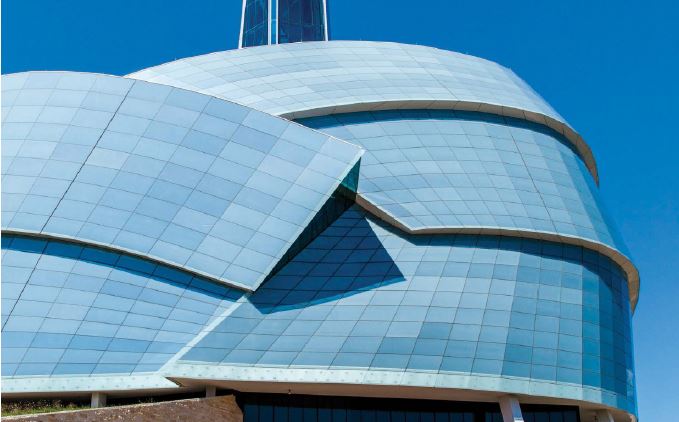
This article originally appeared in the September/October 2018 issue of Museum magazine.
In celebrating Canada’s 150th anniversary, the Canadian Museum for Human Rights attempts to tell the full story of the country’s history and treatment of Indigenous peoples.
For many, the idea of Canada conjures images of polite and peaceful people living together amid a chorus of “I’m sorry” and “Eh.” The nation’s history seems a kind and gentle one, where settlers befriended Indigenous peoples and everyone found a way to work together. Canadians are the nice ones, right?
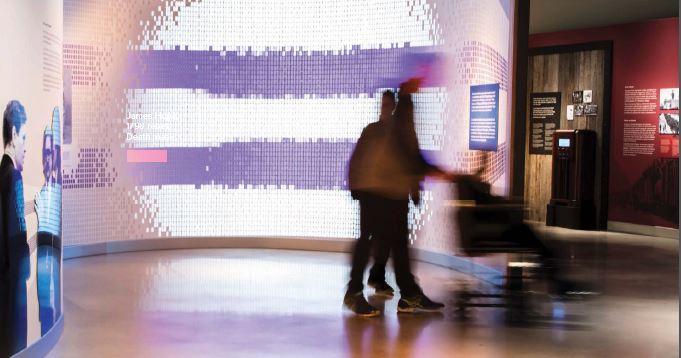
A hard reality check came in 2017. Canada’s 150th anniversary was welcomed by many as an occasion to celebrate their country as a historical and contemporary world model for peace, tolerance, and respect for human rights. Projects and stories for Canada 150, as it came to be known, emphasized themes of diversity, inclusion, youth, the environment, and reconciliation between Indigenous and non-Indigenous peoples.
However, what reconciliation meant, within the context of celebrating confederation, was a contested question. Because for most Indigenous people, Canada 150 was no reason to celebrate. It marked 150 years—and more—of land theft, forced assimilation, and genocide.
Canada 150 presented an important challenge for curators and interpretive staff at the Canadian Museum for Human Rights (CMHR), one of Canada’s national museums. Could we approach the topic of reconciliation as a process, to tell a different kind of story?
The Role of Museums and Archives
In 2012, a federal government committee published a 63-page report detailing how museums could contribute to Canada 150. Encompassing the views of six national museums and nine smaller institutions, the report noted that Canada was a global and multicultural country in which museums could create “a swath of common ground” to celebrate the country’s successes and reputation for tolerance.
But, by 2015, things had changed. That year, the Truth and Reconciliation Commission of Canada (TRC) released its final report. As part of the final settlement in the biggest class action lawsuit in Canadian history, the TRC had conducted an expansive study on Canada’s most egregious human rights abuse story: the history and legacy of the Indian Residential School System.
Between 1884 and 1996, agents of the state forcibly removed 150,000 children from their homes and communities with the intent to “civilize,” by whatever means necessary, the original inhabitants of the land. Residential schools formed a cornerstone of what we now recognize as state-perpetuated genocidal policies within a larger structure of colonization, which included seizing Indigenous lands, displacing Indigenous people, and a full-scale assault on Indigenous nations, communities, and individuals.
The TRC issued 94 calls to action, a blueprint for how all Canadians, in both the public and private sectors, could work toward reconciliation. Some of the calls to action addressed how museums and archives have traditionally withheld essential truths about history in order to create a base consensus about national identity that erased notions of conflict. One call to action urged museums and archives to “fully adopt and implement the United Nations Declaration on the Rights of Indigenous Peoples . . . as related to Aboriginal peoples’ inalienable right to know the truth about what happened and why” in residential schools and beyond. Another asked museums to mark the 150th anniversary of Canadian Confederation with exhibitions and projects based on the theme of reconciliation.
Principle to Practice
At the CMHR, this was an important opportunity. Reconciliation is a complex concept with many meanings. It can take various forms depending on the context. Within societies, reconciliation is the process of building relationships and finding ways to live together that will build a better future. In this way, reconciliation does not happen at once; it is a long-term process in which attitudes and beliefs change.
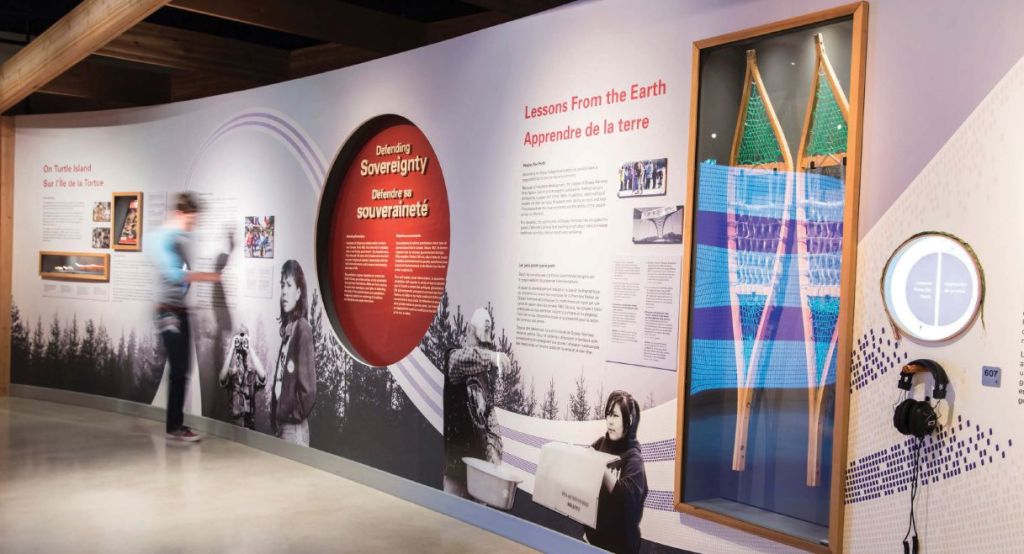
At the CMHR, there were many discussions about the concept of meaningful engagement. How can we demonstrate Indigenous ways of understanding and knowing, in a contemporary context, that were authentic to Indigenous participants themselves? And what is “authentically” Indigenous?
Authenticity, as linked to racialization, erects boundaries on individuals and communities, and on their representation. This is known as “oppressive authenticity.” Many museums have employed oppressive authenticity in their exhibitions involving Indigenous identities, dismissing individuals and communities that do not conform as “inauthentic.”
By contrast, my own approach centers on understanding and applying the principle of “shared authority,” which seeks to redistribute power and provide more beneficial experiences for participants through prior and informed consent. This is an important principle in rethinking the role of heritage institutions. It is only meaningful, however, if we accept the museum as a site of dialogue and a space for competing voices within groups. The museum is not the authority on cultures or peoples as a whole in any given time or place.
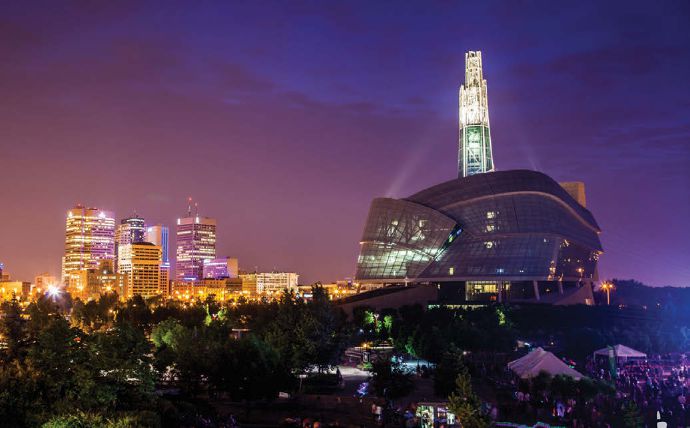
In this spirit, I knew we needed to approach our own exhibitions through a process defined by understanding Indigenous rights, in Indigenous terms, based on the principle of respectful relationships. This approach built on existing CMHR practice, which had, since its opening in 2014, avoided replacing Indigenous voices with an overall “museum voice” and prioritized Indigenous rights violations throughout the museum, in every gallery, as a shared responsibility. In doing so, the museum would avoid creating its own version of history.
The exhibition project “Rights of Passage: Canada at 150” was the opportunity to put these principles into practice. Our task was to create an entirely original exhibition based on 150 years of human rights discourse in Canada, referring specifically to the formal nation-state established through confederation in 1867. Early on, the curatorial dilemmas were apparent. For example, the time span of the exhibition, which references only the period in which the nation-state of Canada has existed, ignores thousands of years of this land’s history and people.
To address this problem, the exhibition introduces a parallel structure of the history of the land through the idea of “kanata.” The word, from which the name Canada is derived, is often interpreted as “the village.” Yet Indigenous knowledge-keepers explained to me that kanata represents a much richer concept, encompassing the relationships of people with each other and with the land, including all of the elements of language, culture, and ceremony that existed prior to the establishment of Canada. Using parallelism to frame the exhibition helps complicate some of the initial messages around unity and introduces the idea of the nation as incomplete, or a work in progress.
Within the exhibition, a zone called “Defending Sovereignty” articulates Indigenous rights, in Indigenous terms. In this space, Canada is presented as a foreign state that has invaded the territories of Indigenous nations. The stories in this section emphasize that sovereignty existed on these lands prior to colonization and continues to be asserted today.
The content in this zone, created from oral histories, is fully collaborative—down to the selection of pictures and the loaning of artifacts. In one case, a survivor of forced relocation lent us a treasured childhood toy and carvings made by his parents. In another, a contributor trusted the museum with her hand-woven sash, her late father’s most treasured possession. All “artifacts” were borrowed directly from contributors, not institutions. This was an expression of trust between myself, as a representative of the institution, and the participants, who helped me understand the value and meaning of their treasures.
The zone’s design also reflects this trust and collaboration. Video monitors are framed by sweetgrass braids that were blessed by elders before installation. The design also incorporates the four sacred medicines—tobacco, sage, sweetgrass, and cedar—collected according to territorial protocols. The overall design traces a two-row wampum belt, reflecting a nation-to-nation relationship between the state and Indigenous peoples.
The Two Row Wampum is one of the oldest treaty relationships between the Onkwehonweh (original people) of Turtle Island (North America) and European immigrants, dating to 1613. It became the basis for all Haudenosaunee (Iroquois) relationships with European powers. The white beads of the belt symbolize peace, friendship, and respect, while the purple rows symbolize two vessels travelling down the same river, neither interfering with the other.
In the exhibition zone, two-row wampum is presented as digital beadwork, incorporating designs created by Indigenous youth from a Winnipeg high school. This speaks to the importance of honoring past relationships in order to live in peace and mutual respect in service of the future. It also represents the young people’s hopes for their communities and their world.
Beyond 150: Reclaiming the History of Turtle Island
Reconciliation, for museums, begins with telling the truth. If this were a storybook, Canada would not be the nice guy. It would be the big bad wolf. But this is not a folk tale.
“Rights of Passage” represents the principles of reconciliation in action. In this exhibition, Indigenous stories are told by building relationships of respect and peace, engaging Indigenous protocols and ways of knowing.
It is the story of me, and the story of us. My ancestors have lived on these lands since time immemorial. Since settlers arrived, we have been ripped apart in thousands of ways. Today, we face legislation that strips us of our rights, one generation at a time. Many of our communities suffer from a lack of proper housing, clean drinking water, and basic infrastructure. Many of our youth are taken. In so many cases, our people are not just uncomfortable—they are literally dying.
These are the stories the CMHR is committed to tell. Reconciliation—no matter how it is defined—always begins with the truth. Indeed, as CMHR President and CEO John Young recently stated: “Denial of one human rights violation is a denial of all. When one atrocity is erased from our past, it makes it easier to deny others.”
It’s time to face the music, so that one day, we might dance
3 Keys to Meaningful Engagement
Ultimately, telling the truth is about investment. Our curatorial practice, which prioritizes a decolonizing methodology, can be messy, complicated, and difficult. But ultimately, it is based in the principles of true collaboration aimed at prioritizing Indigenous worldviews and perspectives in order to create a process that can share the truth as shared history and shared responsibility.
Here are three keys to reaching that point.
- Invest in relationships. Trust is the basis for quality exhibitions featuring the stories and cultures of communities and individuals. Invest in relationships to build that trust. Make peace, friendship, and respect the foundation—not the result—of your collaboration.
- Invest in time. Building relationships with communities takes time, a commodity often lacking in exhibition planning. Invest time into understanding the history and contemporary realities of the stakeholders and communities you hope to engage. Understand that there are many priorities competing with yours, so communities and individuals may require more time than you anticipate to meaningfully participate in the process.
- Invest in resources. True and meaningful collaboration requires money for staff, travel, and research, and to create good relationships. In a digital world, it can be tempting to conduct the work from afar over email, telephone, and online chat, but there is no substitute for interpersonal interaction.
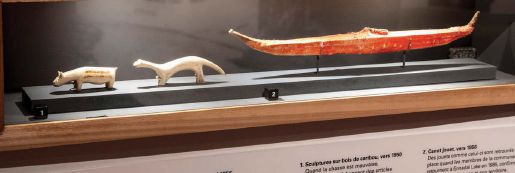
Karine Duhamel is the curator for Indigenous rights at the Canadian Museum for Human Rights in Winnipeg.






